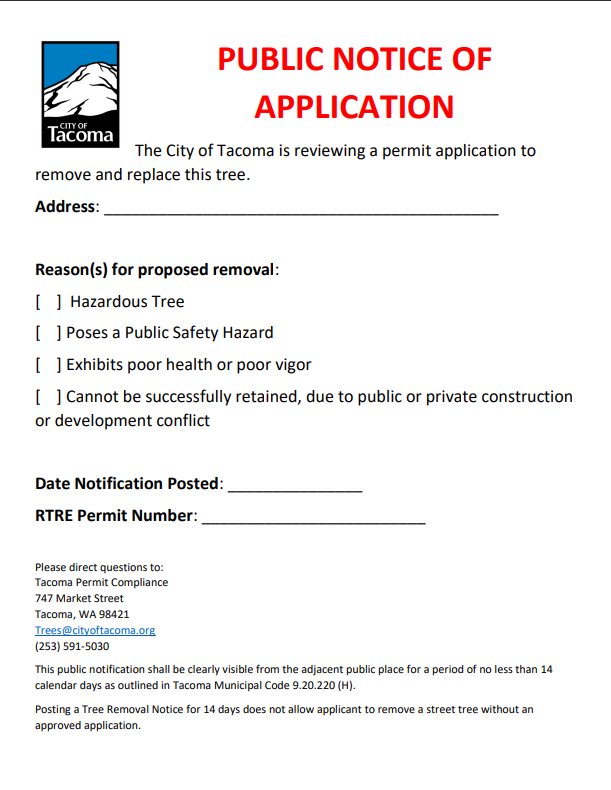Street Tree Removal
Street trees are an integral part of a healthy city. However, there are times when a tree may need to be removed due to disease, decay, or damage. Replacement tree planting is required for all trees approved for removal in the right-of-way.
Permits for Removal/Replacement of Regulated Trees
Removal of trees within the right-of-way (ROW) requires a Tree Work in the ROW permit. All tree planting, pruning and removal work performed within the ROW shall be in compliance with American National Standards Institute (ANSI) A300 and Z133.1 and comply with Tacoma Municipal Code (TMC) 9.20 Urban Forestry and 13.06.090.B, as well as the standards in the Urban Forestry Manual (UFM).
A Tree Work in the ROW Permit may be granted if the adjacent property owner, or the owner’s authorized agent, can sufficiently demonstrate that the tree(s) represent one of the following categories approved for removal candidacy:
- Hazardous Tree; defined as: a tree(s) that is found to be likely to fail and has an extreme or high risk to cause property damage, personal injury or fatality in the event of a failure; designated as such by an International Society of Arboriculture (ISA) Certified Arborist, who has obtained an ISA Tree Risk Assessor Course and Exam certification or Tree Risk Assessment Qualification.
- If a street tree is an imminent hazard, call (253) 591-5495, to request an emergency inspection.
-
- Conflict Tree; a tree that by its presence in the public right-of-way directly conflicts or interferes with (a) construction or installation of a utility or public right-of-way improvement; (b) activities performed in the public right-of-way to repair or maintain a utility or public right-of-way improvement; (c) development of real property nearest to and directly abutting that portion of the public right-of-way upon which the street tree is located; or that, (d) damages existing improvements within the right-of-way or abutting property. A tree conflicts or interferes when it is demonstrated that there are no reasonable alternatives available to removal of the conflict tree.
- Conflict Tree Removals are subject to a Canopy Loss Fee of $125/caliper inch of tree removed minus an equal caliper inch credit for replacement trees planted.
- Example: One 10-inch caliper tree is removed, three 2-inch caliper trees are replanted.10 inches minus 6 inches (three 2-inch trees) equals 4 inches X $125 = Canopy Loss Fee of $500.
- Tree Damaging Sidewalk
- Prohibited Tree; a species of tree that is unlawful to plant in the public right-of-way pursuant to the adopted Prohibited Tree List of the Urban Forest Manual.
- Nuisance Tree; a tree that constitutes a public nuisance pursuant to Chapter 8.30 TMC.
- Fruit Tree
- Significantly Damaged Tree; a tree that has been previously topped or significantly damaged to an extent that, if left unmanaged through extensive pruning and maintenance, could become a future Hazard Tree.
Canopy Loss Fee only applies to Conflict Trees. All other Tree Work in the ROW permit types are no-fee permits.
All stumps and surface roots of trees removed shall be ground or removed to at least 8 inches below the surface of the ground.
The following shall not be considered criteria for removal:
- Obstruction of view
- The cost of routine tree maintenance (pruning, watering, fertilizing, etc.)
- Normal maintenance such as raking of leaves and flowers and cleaning of gutters
- Hazards that can be controlled or eliminated through appropriate pruning or maintenance
- Potential damage to public infrastructure or private property, if damage can be avoided by pruning, root pruning, root barriers or other management strategies
Posting of Public Notice Requirement
A Tree Removal Notice is required to be posted on affected tree(s) as part of every Tree Work in the ROW Removal permit. Removal Notices must be in place for a minimum of 14 days prior to removal as a condition of permit issuance. You may post a Tree Removal Notice yourself when submitting your removal permit application. You do not need to wait for permit approval to post the tree and begin the 14-day notice period.
Tree Removal Notices must be posted using the following standards:
- Removal Notices must remain on the tree for at least 14 calendar days prior to removal.
- You are advised to put the Notice in a plastic sleeve before posting to make it rain resistant. The person posting the Notice is responsible for ensuring it withstands the elements for the 14-day period.
Upload a photo of the tree with posted public notice as part of your Tree Work in the ROW permit application.
This public notification shall be clearly visible from the adjacent public place for a period of no less than 14 calendar days as outlined in Tacoma Municipal Code 9.20.220 (H).
Right-of-Way Tree Removal Notice Template

Posting a Tree Removal Notice for 14 days does not allow applicant to remove a street tree without an approved application.
Wood Waste Diversion (higher uses than firewood)
Consider other uses for the wood generated from pruning and removals. Below are some local and regional companies utilizing urban wood to create furniture and art.